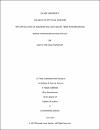Enhancing oil removal from water using ferric oxide nanoparticles doped carbon nanotubes adsorbents
| المؤلف | Fard, Ahmad Kayvani |
| المؤلف | Rhadfi, Tarik |
| المؤلف | Mckay, Gordon |
| المؤلف | Al-marri, Mohammed |
| المؤلف | Abdala, Ahmed |
| المؤلف | Hilal, Nidal |
| المؤلف | Hussien, Muataz A. |
| تاريخ الإتاحة | 2021-09-01T10:03:32Z |
| تاريخ النشر | 2016 |
| اسم المنشور | Chemical Engineering Journal |
| المصدر | Scopus |
| الملخص | Oil contaminated water is one of the challenges in water resources management. It is crucial to remove the oil droplets from water in order to meet the discharge regulations set by the environmental authorities. Carbon nanotubes (CNTs) have generated a lot of attention as a new type of adsorbent due to their exceptionally high adsorption capacity for oil-water separation. The high hydrophobicity of CNTs makes them good candidates to enhance the de-oiling process from wastewater. In this study, we have reported the synthesis and evaluation of novel iron-oxide/CNTs nanocomposites for oil-water separation. The CNTs were doped with different loadings of iron oxide nanoparticles using a wet impregnation technique. The synthesized nanocomposite nanomaterials were characterized using field emission scanning electron microscopy (FE-SEM), high resolution transmission electron microscopy (TEM), Brunauer, Emmett and Teller (BET) technique, X-ray diffraction (XRD), and thermogravimetric analysis (TGA). The effect of adsorption parameters, including, adsorbent dosage, contact time, and agitation speed on the oil removal efficiency were optimized using batch experiments. The sorption capacities of doped CNTs were found to be greater than 7 g/g for gasoline oil. The doped CNTs reached maximum sorption capacity after only 15 min providing one of the fastest minimum contact times reported of all oil sorbent materials. The loading of Fe2O3 nanoparticles on the negative surface of CNT decreases the negative sign and magnitude of the zeta potential by overcoming the repulsive effects of the electrical double layers to allow the finely sized oil droplets to form larger droplets through coalescence. Therefore increasing percentage of the Fe2O3 on the surface of CNT increased the removal of the emulsified oil from the water. 2016 Elsevier B.V. |
| راعي المشروع | The authors are grateful to the Qatar Environment and Energy Research Institute (QEERI), Qatar Foundation for financial support under project WGC-4004. Also, the authors are grateful to Mr. Faraj Ahmed Abuilliw, General Science and Studies Unit, Hafr AlBatin Community College, Hafr AlBatin, King Fahad University of Petroleum & Minerals (KUFPM), Saudi Arabia for providing raw material for this study. |
| اللغة | en |
| الناشر | Elsevier B.V. |
| الموضوع | Adsorption Carbon nanotubes Chemicals removal (water treatment) Drops Emulsification Enamels Environmental regulations Field emission microscopes Hematite High resolution transmission electron microscopy Magnetic nanoparticles Metal nanoparticles Nanocomposites Scanning electron microscopy Thermogravimetric analysis Adsorption capacities Ferric oxide nanoparticle Field emission scanning electron microscopy Iron oxide nanoparticle Oil removal Oil removal efficiencies Oil water separation Water resources management Water pollution |
| النوع | Article |
| الصفحات | 90-101 |
| رقم المجلد | 293 |
تحقق من خيارات الوصول
الملفات في هذه التسجيلة
| الملفات | الحجم | الصيغة | العرض |
|---|---|---|---|
|
لا توجد ملفات لها صلة بهذه التسجيلة. |
|||
هذه التسجيلة تظهر في المجموعات التالية
-
الأبحاث [479 items ]




